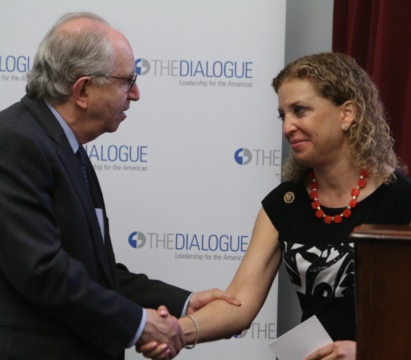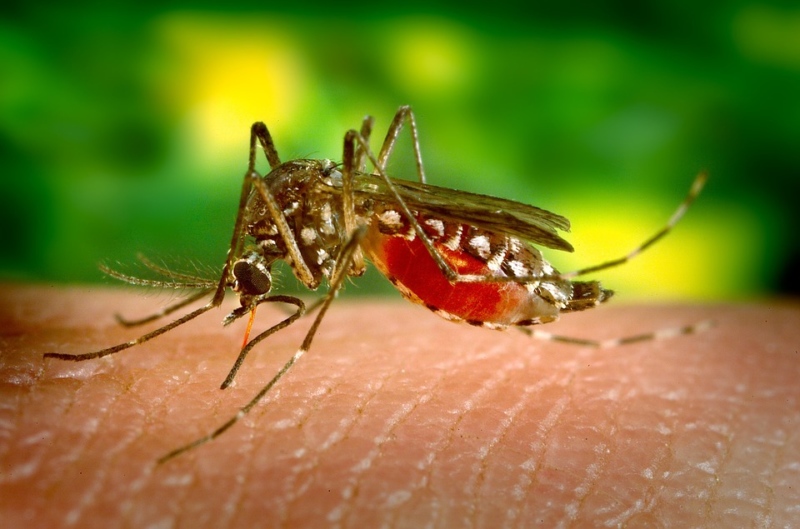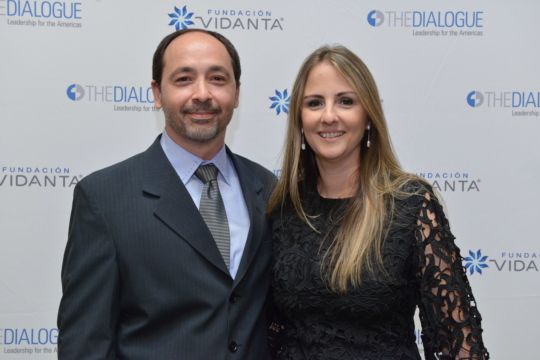
Capitol Hill Symposium: Zika Crisis & Implications for US Policy
Lawmakers join the Dialogue and the O’Neill Institute for National and Global Health in open discussion on the Zika virus as a global health crisis.
Since first appearing in the Western Hemisphere in February 2015, the Zika virus has spread rapidly throughout South and Central America, reaching Mexico in November 2015 and the United States in early 2016. The virus is spread by the Aedes aegypti mosquito, which is commonly found throughout the tropical and subtropical Americas. Most Zika infections are asymptomatic, although one in five cases can result in a mild fever and rash. Critically, Zika virus infections in pregnant women have a suspected link with microcephaly, a severe neurological condition in newborns. In addition, Zika is suspected of being associated with an increase in cases of Guillain–Barré syndrome, a neurological condition causing serious complications including cardiac arrest and paralysis.
The Zika virus has already spread to 31 countries and territories in the region and it does not appear to be slowing down. In January, the World Health Organization (WHO) warned that the virus is likely to spread to nearly all countries of the Americas by the end of the year. According to the WHO, the first cases of the Zika virus were confirmed in Brazil in May 2015. The last official report sent to the WHO dated December 1 2015 indicated 56,318 suspected cases of Zika. Brazilian national authorities have since stopped counting cases, however experts estimate between 500,000 and 1,500,000 cases of the Zika virus within the country. Colombia is second only to Brazil in terms of the number of people infected with Zika with 16,419 cases confirmed as of January 2016. El Salvador reported 3,836 cases, Panama reported 99 cases, and Mexico reported 93 cases of the Zika virus as of early 2016. In Venezuela, the government reported an estimated 5,000 cases, but public health experts and doctors believe that the government is dramatically lowering the reported numbers of the disease. Independent experts estimate that there have been more than half a million cases of Zika in Venezuela, making it the second-largest total behind Brazil.
To date, 153 cases of Zika have been reported in US states, including new cases in Texas, Florida, and California. Thus far, all of the cases in US states are travel-related. However, US territories, specifically Puerto Rico, have seen alarmingly fast rates of transmission. Puerto Rico currently reports 102 cases, all of which were locally transmitted. Dr. Thomas Frieden, director of the Centers for Disease Control, described the problem as “particularly scary,” during a congressional hearing, adding that unless preventative measures are taken, the virus could spread to hundreds of thousands on the island, and suggested that Zika could be locally transmitted in US states.
As the Zika virus has spread throughout the region, doctors and researchers have emphasized concern over links between the virus and its effect on fetal development. Recently, the New England Journal of Medicine conducted a study on 88 pregnant women in Rio de Janeiro. Researchers found that 29 percent of women who had ultrasound examinations after testing positive for the Zika virus had fetuses that suffered “grave outcomes.” These included fetal death, tiny heads, shrunken placentas, and nerve damage that suggested blindness. Dr. Anthony Fauci, director of the National Institute for Allergy and Infectious Disease (NIAID), agreed that the small size of the study was “a limitation,” yet, the high percentage of fetuses damaged is of concern. The World Health Organization is also awaiting results from a similar, but much larger, study involving 5,000 women, mostly from Colombia. The results are not expected until May or June, when large numbers of the babies will come to term. The virus first arrived in Colombia in September 2015 and, by December the country had set up national tracking programs to monitor pregnant women for signs of infection, and to spot early signs of birth defects in fetuses. Since then, researchers have been waiting to see whether Colombia might experience a similar rise in birth defects. Most recently, researchers have diagnosed one newborn with microcephaly and two others with congenital brain abnormalities. All three infants tested positive for Zika.
In the United States, the CDC is working to establish a registry of pregnant women who may be at risk. According to the Washington Post, of nine confirmed cases in pregnant women, at least two recently chose to have abortions, two suffered miscarriages, and one gave birth to a child with serious birth defects. Clinical evidence leaves little doubt that a link between Zika and microcephaly exists: the virus has been detected in amniotic fluid, in the cerebrospinal fluid of affected babies and in the brains of fetuses.
While much of the conversation around Zika and its rapid spread throughout the Western Hemisphere is still focused on its link to fetal abnormalities, recent studies are now also linking Zika to other diseases, including Guillain-Barré syndrome (GBS). Guillain-Barré syndrome is a disorder in which the body’s immune system attacks part of the peripheral nervous system. The first symptoms of the disorder include varying degrees of weakness or tingling sensations in the legs and, according to the National Institute of Neurological Disorders and Stroke (NINDS), these symptoms can increase in intensity until certain muscles cannot be used at all. When severe, GBS can leave the person almost totally paralyzed. Most individuals recover fully from even the most serious cases of GBS, although some continue to experience weakness.
The first links between the Zika virus and Guillain-Barré syndrome were discovered during an outbreak in French Polynesia in 2013-2014. At the time, 42 GBS cases were identified in the territory, a spike from usual rates, and retrospective testing revealed that all patients suffered from Zika at the time. In July 2015, Brazil reported 42 GBS cases in the state of Bahia, among them 26 (62 percent) with a history of symptoms consistent with Zika. In November 2015, seven patients presenting with neurological syndromes, including GBS, were confirmed for Zika. In February 2016, Colombia reported an increase in cases of GBS. From mid-December 2015 to late January 2016, 86 GBS cases were reported, a huge spike considering that there have only been 223 cases of GBS in Colombia in the past seven years. According to a situation report published by the WHO in February 2016, Brazil, Colombia, El Salvador, Suriname, and Venezuela have all reported a significant increase in the number of cases of GBS.
Given recent information about the Zika outbreak and its links to neurological disorders and fetal abnormalities, government agencies and international organizations have been working to find a solution. Recently, international researchers convened at the Pan-American Health Organization (PAHO) headquarters to assess the situation. It was determined that research efforts must be “ramped up” to explore unknown factors in microcephaly and congenital malformations that may be linked to the Zika virus. Dr. Marcos Espinal, director of PAHO/WHO's Department of Communicable Diseases, said:
“Our most important tool to combat Zika—and at the same time, dengue and chikungunya—is control of the Aedes aegypti mosquitoes that transmit these diseases.Since these mosquitoes live in and around houses, this will take a concerted effort with intensified community engagement to reduce the number of mosquitoes in the Americas. We are also looking urgently at improving control methods including insecticides and other technologies.”
In order to achieve these goals, the WHO is appealing for a sum of US $56 million for an inter-agency international response to the spread of Zika and subsequent spikes in cases of microcephaly and neurological disorders. The World Bank Group announced on February 18, 2016 that it has made US $150 million immediately available to support countries in the Western Hemisphere affected by the outbreak.
Following a February 5 meeting in Geneva, the UN High Commissioner for Human Rights Zeid Ra’ad Al Hussein has also weighed in on the conversation. Following initial discovery of links between the Zika virus and fetal abnormalities, many countries in the region urged women to postpone getting pregnant. However, according to Mr. Zeid, this “ignores the reality” of many women and girls in the region, who oftentimes “cannot control whether or when they become pregnant”. More importantly, the UN High Commissioner for Human Rights has urged governments where laws and policies restrict access to sexual and reproductive health services to urgently review these policies. He added that governments must take concrete steps to ensure that women have “the information, support, and services they require to exercise their rights to determine whether and when they become pregnant.” This call for action has increased relevance following confirmation by the WHO on March 8, 2016 that the Zika virus can be transmitted through sexual intercourse, seriously broadening the risk groups.
In the United States, researchers are also working to discuss other preventative measures and develop a vaccine. The White House and the US Centers for Disease Control and Prevention (CDC) will gather state and local officials for a meeting on April 1st to craft a plan to attack the mosquito that spreads the Zika virus. This summit will focus primarily on how to best track and control the spread of the virus, and respond when people are affected. The first locally transmitted cases in the United States are expected in June or July of this year.
According to the Wall Street Journal, about 15 drug companies are working on Zika vaccines, with the most advanced studies coming from Bharat Biotech International Pvt. Ltd. in India and the US National Institute of Allergy and Infectious Diseases (NIAID). The WHO director-general for health systems and innovation predicted it will take at least 18 months for large-scale trials to get under way, but Dr. Fauci of NIAID has said that a vaccine should be ready for initial human trials towards the end of the summer or early fall. Developing new vaccines can take decades, but researchers at NIAID have been able to fast-track their work by piggybacking on previous research done on dengue and West Nile virus, which are both similar to Zika and carried by the same Aedes aegypti mosquito. Dr. Barney Graham, deputy director of the National Institute of Health Vaccine Research Center said to BBC that one challenge is “that we don’t know a lot about Zika, but we know a lot about other flaviviruses [the virus family].” The NIH/NIAID vaccine will primarily focus on pregnant women, and women of childbearing age, with a longer-term goal of offering a vaccine to everyone. However, despite these advanced efforts, NIH believes that the earliest a vaccine could be widely distributed is around 2018.
Although there is no current solution to this growing epidemic, the current Zika outbreak and its possible association with microcephaly, other congenital malformations, and GBS have caused increasing alarm in countries across the hemisphere. The WHO warns that major epidemics of Zika may occur globally since environments where mosquitoes can live and breed are expanding due to recent trends in climate change and urbanization. In order to best halt the spread of Zika, the WHO has outlined a response that involves community engagement and educational campaigns, increased efforts to control the spread of the Aedes aegypti mosquito, and to provide guidance and “mitigate the potential impact on women of childbearing age or those who are pregnant,” as well as families with children affected by the Zika virus.
Rapid responses by drug companies and research institutes, such as NIAID, are also a major component of the global response to Zika; however, companies have capitalized on past research on similar viruses, such as dengue, in order to speed up the process. Through persistent international and inter-agency support, research institutions will be able to continue the research necessary to develop successful vaccines for the disease. This, combined with quick efforts by the WHO, will allow for a more effective response to this public health emergency.
A full report detailing the WHO’s strategic response plan can be found here.
Lawmakers join the Dialogue and the O’Neill Institute for National and Global Health in open discussion on the Zika virus as a global health crisis.
On November 15, 2016, the Inter-American Dialogue and the O’Neill Institute for National and Global Health Law convened a private roundtable discussion on funding for the current Zika virus outbreak in the Americas. In September 2016, the US Congress approved $1.1 billion for the emergency Zika response, which raises a number of important questions around funding allocation and priority setting, both domestically and globally.
The Covid-19 pandemic has once more demonstrated the fragility of Latin American regional and subregional organizations, and the reasons for it: the weaknesses of domestic institutions, the lack of shared interests and values, and the dependence on foreign powers. It is not too late to turn the pandemic into an opportunity to acknowledge the existence of common interests, and the value of pursuing them collectively.


